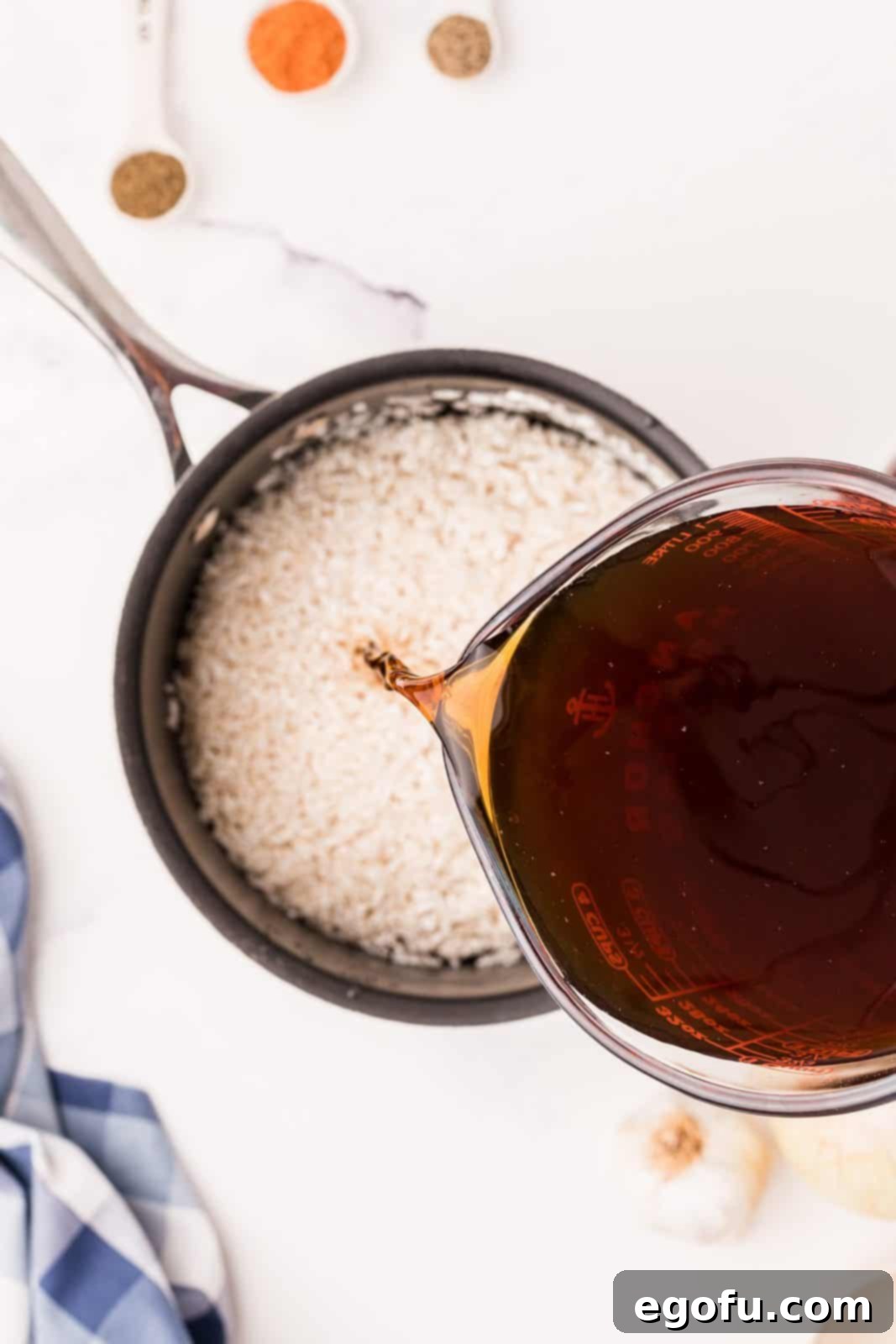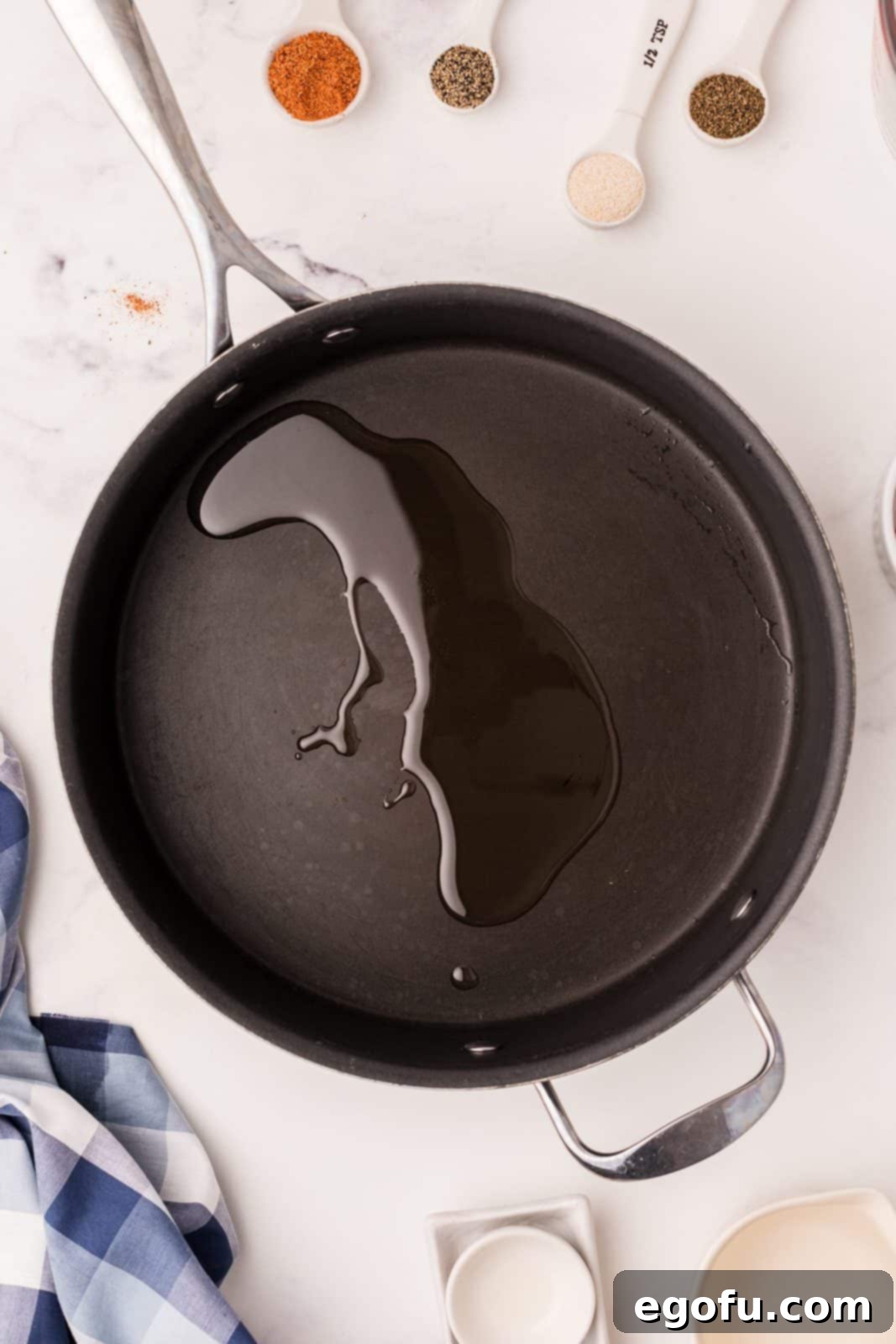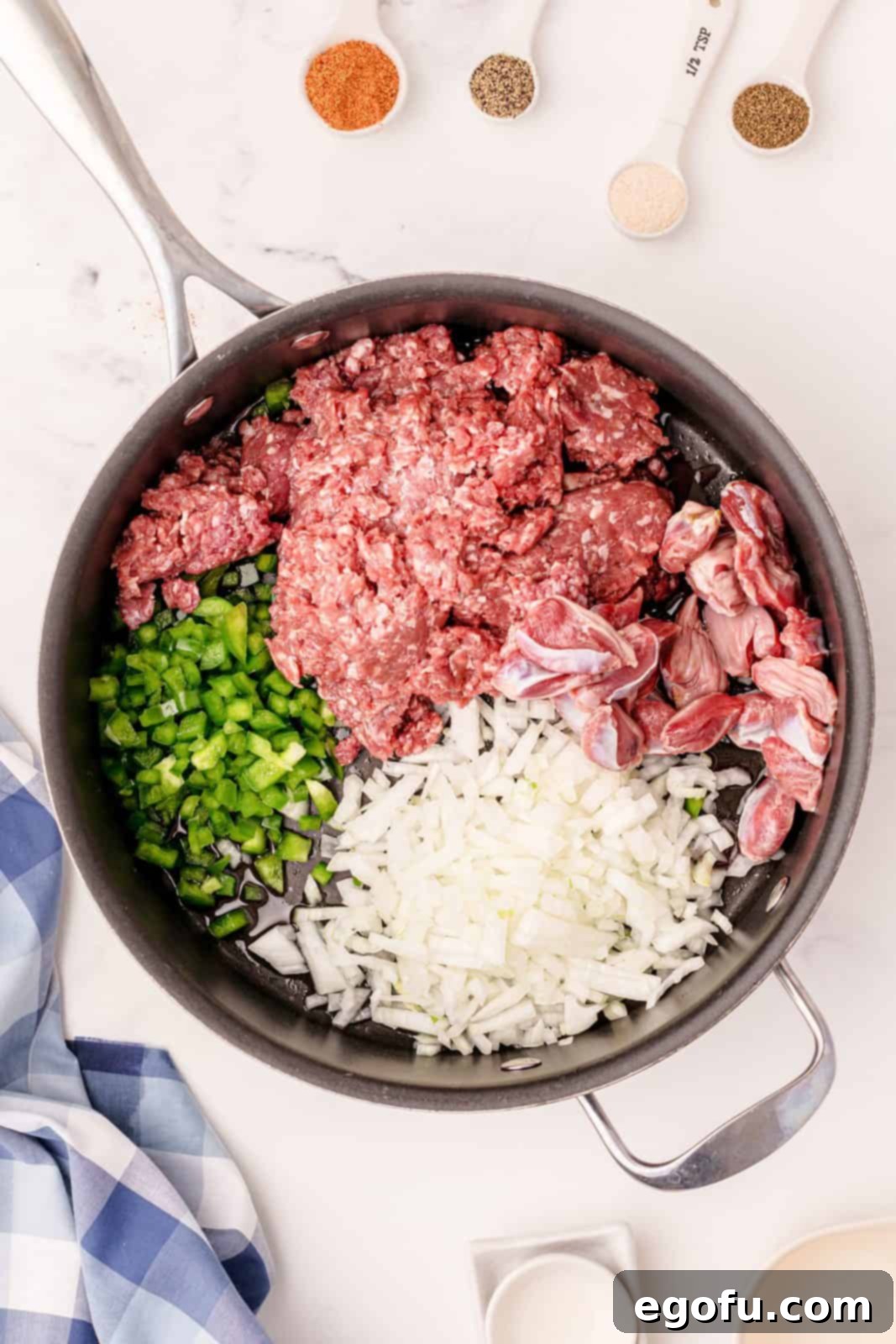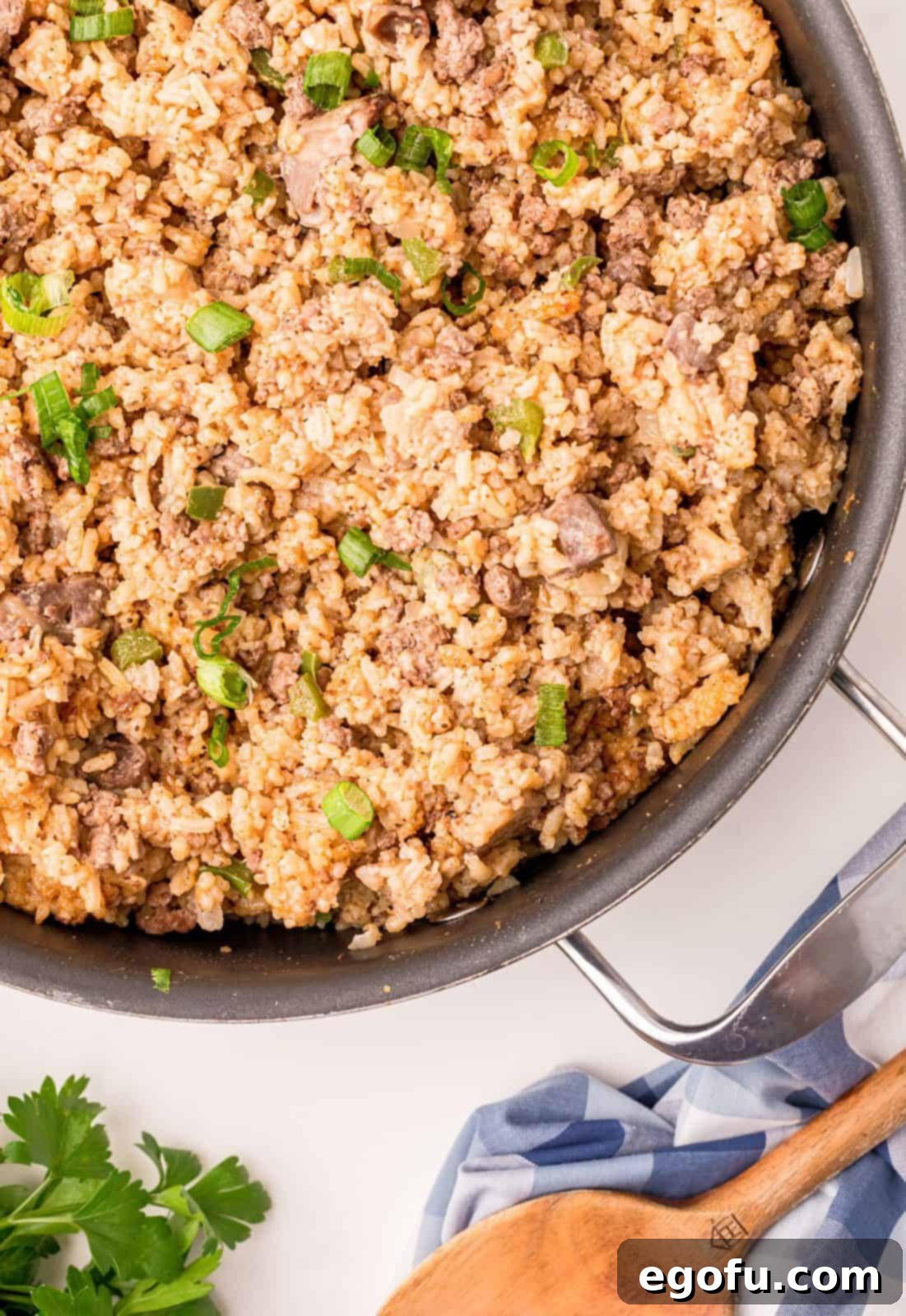Diving into the heart of Southern cuisine reveals a treasure trove of flavors, and few dishes capture the essence of Louisiana cooking quite like Cajun Dirty Rice. This iconic dish, celebrated for its perfectly seasoned rice and a savory medley of meats, stands as a versatile staple in homes across the South. It’s equally adept at serving as a robust, flavorful side dish to complement any main course or as a satisfying, complete meal in its own right. The magic of Dirty Rice lies in its distinctive “dirty” appearance—a beautiful, earthy brown hue that results from the rice absorbing the rich, aromatic pan drippings and spices from the browned meats. This rustic color is not just a visual cue; it’s a promise of the profound depth of flavor awaiting you. More than just a recipe, Dirty Rice embodies a rich tapestry of cultural fusion and culinary resourcefulness, telling a story of tradition, ingenuity, and pure deliciousness.
The Intriguing Story and Cultural Roots of Cajun Dirty Rice
The name “Dirty Rice” often piques curiosity, but its origin is wonderfully simple and descriptive. The dish earns its moniker from the light brown color the rice acquires as it cooks, infused with the rich seasonings, herbs, and finely minced meats and vegetables. This earthy transformation made it look “dirty” to early cooks, and the charming name stuck, becoming a hallmark of its authentic, rustic appeal. Yet, the story of Dirty Rice is far richer than its name suggests; it’s a vibrant narrative woven from diverse cultural threads, predominantly French and African influences, that converged in the unique melting pot of Louisiana.
My personal appreciation for Dirty Rice deepened significantly after a conversation with a kind Cajun neighbor, who not only shared his family’s cherished recipe but also illuminated its historical significance. He explained how this dish, passed down through generations, reflects the resourceful spirit and ingenious flavor development characteristic of traditional Cajun kitchens. It’s a testament to how different cultures adapted their culinary traditions with available ingredients, creating something truly extraordinary. Each spoonful of this Dirty Rice recipe offers a glimpse into that rich heritage, a culinary journey that speaks volumes about the region’s identity. It is my sincere hope that you will cherish this authentic Dirty Rice recipe as much as our family does.

Cajun and Creole Culinary Traditions: A Louisiana Distinction
To fully grasp the essence of Dirty Rice, it’s helpful to understand the nuanced culinary landscape of Louisiana, shaped predominantly by two distinct yet often conflated cultures: Cajun and Creole. While many outside the region use these terms interchangeably, they represent unique historical journeys and gastronomic traditions that have profoundly influenced the state’s iconic dishes.
Cajun culture finds its roots in the Acadians, French colonists who settled in Nova Scotia, Canada, in the 17th century. Following their expulsion by the British in the mid-18th century—an event known as “Le Grand Dérangement”—many Acadians embarked on a arduous journey, eventually finding refuge in the remote bayous and prairies of Southwest Louisiana. Drawn by land offers from the Spanish, who aimed to curb British expansion along the Mississippi, these resilient settlers brought with them a pragmatic, rustic approach to cooking. Their cuisine evolved out of necessity, utilizing local ingredients like crawfish, shrimp, and indigenous game, resulting in the hearty, one-pot meals characteristic of traditional Cajun food.
Creole culture, conversely, emerged primarily from the vibrant, cosmopolitan port city of New Orleans. It refers to the descendants of the diverse colonial population, encompassing French, Spanish, African, and Native American heritage. New Orleans Creole cuisine is often characterized by its sophisticated blending of European and African culinary techniques, frequently featuring rich, butter-based sauces, the liberal use of tomatoes, and a broader spectrum of spices. While Cajun cooking typically relies on the “holy trinity” of onion, celery, and bell pepper, Creole cuisine often expands this base to include garlic and tomatoes, leading to a more refined and layered flavor profile.
Dirty Rice is a remarkable culinary ambassador, beautifully bridging these two rich traditions. It embodies the resourcefulness inherent in both Cajun and Creole cooking, particularly in its clever utilization of various meats, including cuts that might otherwise be overlooked. This practice is a direct legacy of the ingenious culinary adaptations developed by enslaved Africans, who, often working with limited and undesirable ingredients, transformed them into dishes of incredible flavor and sustenance. Furthermore, the widespread cultivation and integration of rice into American Southern agriculture, especially in Louisiana, owe an immense debt to the invaluable knowledge and expertise of enslaved Africans, who brought advanced rice-growing techniques from their homelands.
Frequently Asked Questions About Authentic Dirty Rice
Do I have to include gizzards in Dirty Rice?
While traditional and authentic Dirty Rice recipes frequently feature chicken gizzards or chicken livers, their inclusion is entirely optional. The historical use of gizzards and livers is rooted in the “nose-to-tail” cooking philosophy, where every part of an animal was utilized to prevent waste. In the era when this dish originated, ground beef was often considered a luxury, making gizzards a more common and accessible protein source. If the unique flavor or texture of gizzards isn’t to your liking, feel free to omit them. You can compensate by increasing the amount of ground beef or substituting with another preferred meat.
What exactly is a chicken gizzard?
A chicken gizzard is a small, robustly muscular organ found in a chicken’s digestive system, responsible for grinding food. It’s a surprisingly healthy and nutrient-rich cut of meat that is regrettably often overlooked in modern Western cooking. Historically, in the context of the American South, enslaved Africans were often provided with cuts of meat that were deemed less desirable or “inedible” by white colonizers. Through extraordinary ingenuity and creativity, these individuals mastered the art of transforming such humble ingredients, like gizzards, into deeply flavorful and satisfying dishes. This practice not only showcased their incredible culinary skill and resourcefulness but also profoundly influenced the development of Southern and African-American culinary traditions, including dishes like Dirty Rice.
Are there other meat options I can use?
Dirty Rice is remarkably adaptable, allowing for a variety of meat substitutions to suit different preferences. In addition to ground beef and chicken gizzards, you can use ground pork, ground sausage (such as breakfast sausage for a milder flavor), or even a spicy andouille sausage for a more pronounced Cajun profile. Some variations also include chopped chicken or turkey. The key to developing that characteristic “dirty” flavor and appearance is to ensure that whatever meat you choose is thoroughly browned to create a rich, savory base.
Why is rinsing the rice a necessary step?
Rinsing the rice thoroughly before cooking is a critical step that ensures the ideal texture for your Dirty Rice. This process effectively removes excess surface starch from the rice grains. If this starch is not washed away, it can cause the rice to become sticky and gummy during cooking, rather than yielding the desired fluffy, separate grains. Simply rinse the rice under cold running water in a fine-mesh sieve until the water runs completely clear and is no longer cloudy. This simple preparation makes a substantial difference in the final quality of your dish.
Can I easily double this Dirty Rice recipe?
Yes, this Dirty Rice recipe is perfectly suited for scaling up! Whether you’re preparing for a larger gathering or simply want to ensure you have delicious leftovers, feel free to double or even triple the ingredients. When increasing the quantities, it’s advisable to use a significantly larger pot or Dutch oven rather than a standard skillet. This provides ample space for even cooking and thorough mixing. Remember to adjust the sautéing times slightly as needed to ensure all meats and vegetables are properly browned and tender.
How should I store Dirty Rice leftovers?
To maintain the freshness and flavor of your Dirty Rice leftovers, proper storage is essential. Once the dish has cooled down to room temperature, transfer it to an airtight container. It can then be safely stored in the refrigerator for up to 4 days. For extended preservation, Dirty Rice freezes exceptionally well. Place it in a freezer-safe container or heavy-duty freezer bags, ensuring as much air as possible is removed, and it will keep for up to 3 months. When ready to enjoy, thaw it overnight in the refrigerator and gently reheat on the stovetop or in the microwave, adding a small splash of broth if necessary to restore moisture.
What are the best dishes to serve with Dirty Rice?
Dirty Rice is incredibly versatile and serves as an excellent complement to a wide range of Southern dishes. As a hearty side, it pairs beautifully with grilled or fried chicken, tender pork chops, baked fish, or even a perfectly seared steak. It’s also a natural partner for classic Louisiana comfort foods like Shrimp Étouffée, a rich Gumbo, or a robust Jambalaya. For a simpler, satisfying meal, serve it alongside a crisp green salad, braised collard greens, or a side of cornbread. Its rich, savory, and slightly spicy profile makes it a fantastic foundation for almost any Southern-inspired meal.
Is Dirty Rice identical to Cajun Rice?
Yes, generally speaking, “Dirty Rice” and “Cajun Rice” are commonly used interchangeably to describe this flavorful dish. Historical evidence suggests that Dirty Rice was indeed a culinary innovation of the Acadian immigrants, who would eventually become known as “Cajuns” in Louisiana. These settlers adeptly merged their traditional French cooking methods with the bounty of local ingredients and the profound culinary techniques introduced by enslaved Africans, leading to the evolution of this distinctive rice dish. While “Creole” and “Cajun” denote unique cultural groups with their own nuanced culinary identities, Dirty Rice stands as a prime example of the rich cross-cultural exchange that defines Louisiana’s diverse food traditions. To explore more authentic Cajun recipes and delve deeper into the culture, I highly recommend visiting the Louisiana Woman Blog.

Essential Ingredients for Your Authentic Dirty Rice
Creating an exceptional Dirty Rice begins with carefully selecting and understanding each ingredient. Every component plays a pivotal role in building the complex, comforting, and utterly delicious flavors that define this Southern classic. While the comprehensive recipe card below provides precise measurements, let’s explore the key elements that make this dish shine:
- Long Grain Rice: This forms the bedrock of our dish. Long grain rice is specifically chosen for its ability to cook up light, fluffy, and with separate grains. This characteristic is crucial, as it allows the “dirty” seasoning and meaty flavors to evenly coat each grain without resulting in a sticky or gummy texture.
- Beef Broth: More than just cooking liquid, beef broth provides a rich, savory foundation for the rice, infusing it with deep flavor right from the start. This contributes significantly to the dish’s overall richness.
- Canola Oil: A neutral-flavored oil, canola is ideal for sautéing and browning the meats and vegetables without imparting any undesirable tastes that could detract from the authentic Southern spice profile.
- Lean Ground Beef: A primary source of both robust flavor and satisfying texture. Opting for lean ground beef ensures that the dish is rich without being excessively greasy, allowing the intricate blend of spices to truly stand out.
- Chicken Gizzards (optional): For those seeking a truly traditional and authentic taste, chicken gizzards add a distinct, earthy flavor and a pleasantly chewy texture. Many Dirty Rice purists consider them essential. If you choose to omit them, you might consider slightly increasing the amount of ground beef or adding another complementary meat.
- Green Bell Pepper: A foundational component of the “holy trinity” (onion, celery, bell pepper) in Cajun and Creole cooking. It contributes a fresh, slightly sweet, and aromatic depth to the dish.
- Sweet Onion: The second pillar of the holy trinity, sweet onion provides a crucial aromatic base, caramelizing slightly during sautéing to add layers of subtle sweetness and pungency.
- Garlic: Pungent, aromatic, and indispensable. Minced garlic is vital for deepening the savory profile and adding a signature zest that is characteristic of Louisiana cuisine.
- Celery Seed: This powerful spice offers a concentrated burst of celery flavor, enhancing the dish’s overall aromatic complexity without requiring additional fresh celery (though fresh celery can certainly be added if desired for extra texture and freshness).
- Creole Seasoning: The absolute heart and soul of the spice blend. A high-quality Creole seasoning, such as Tony Chachere’s, delivers the quintessential balance of savory, spicy, and herbaceous notes that define Dirty Rice.
- Onion Powder: Used to reinforce and deepen the inherent onion flavor, ensuring it permeates every aspect of the dish and provides an even distribution of taste.
- Cayenne Pepper: This provides that characteristic Southern warmth and a pleasant kick of heat. The amount can be adjusted to perfectly match your personal preference for spice.
- Ground Black Pepper: A universal flavor enhancer, ground black pepper adds a sharp, woody undertone that beautifully complements and rounds out the other aromatic spices.
- Water: Used in conjunction with beef broth, water helps achieve the perfect cooking consistency for the rice and contributes to the overall moisture of the dish.
- Green Onion (for garnish): Freshly chopped green onions are added just before serving. They provide a vibrant, zesty finish, a touch of color, and a final layer of freshness that brightens the entire dish.

Step-by-Step Guide: How to Make Authentic Dirty Rice
Crafting a truly authentic and flavorful Dirty Rice is a rewarding culinary endeavor. While the process is straightforward, paying close attention to each step ensures a dish with a perfectly balanced texture and rich, complex flavors. Follow these detailed instructions to recreate the beloved taste of Louisiana in your own kitchen:
1. Prepare and Cook the Rice
Begin by thoroughly rinsing the long grain rice under cold running water. This crucial step is key to achieving fluffy, separate grains rather than a sticky or gummy texture. Continue rinsing until the water flowing from the rice is completely clear, indicating that excess starch has been removed. Once rinsed, transfer the rice to a medium-sized pot and pour in the specified amount of beef broth. Bring the mixture to a rolling boil over medium-high heat. As soon as it boils, reduce the heat to its lowest setting, cover the pot tightly with a lid, and allow it to simmer undisturbed for approximately 20 minutes. During this time, the rice will absorb all the liquid and become tender. It’s important not to lift the lid during this cooking period, as doing so releases steam critical for proper rice preparation.

2. Brown the Meats and Sauté the Aromatics
While your rice is gently simmering, begin preparing the flavorful meat and aromatic base. Heat the canola oil in a large skillet (ideally 12-inches or larger) or a sturdy Dutch oven over medium heat. A generous surface area is vital for achieving proper browning. Once the oil shimmers, add the lean ground beef and the chicken gizzards (if you’re including them). Break up the ground beef with a spoon and cook, stirring occasionally, until it is thoroughly browned and no pink remains. Continue cooking the gizzards until they are tender and beautifully browned. Next, add the chopped green bell pepper, diced sweet onion, and minced garlic to the skillet with the cooked meat. Sauté these aromatics for about 8-10 minutes, or until the vegetables have softened, become translucent, and are fragrant, releasing their delicious flavors into the mixture. Ensure the meat is crumbled finely during this process to integrate well with the rice.


3. Infuse with Spices and Liquid
Once your meats are browned and your aromatics are tender and fragrant, it’s time to build the signature flavor profile. Add the remaining seasonings to the skillet: celery seed, Creole seasoning, onion powder, cayenne pepper, and ground black pepper. Pour in the additional ½ cup of water. Stir everything together thoroughly, ensuring the spices are evenly distributed and coat the meat and vegetable mixture completely. Allow this mixture to simmer for a couple of minutes, stirring gently, which enables the flavors to meld beautifully and the water to slightly reduce. This crucial step is what truly develops the rich, complex, and deeply savory taste that is the hallmark of authentic Dirty Rice.

4. Combine the Rice and Serve with Garnish
Finally, carefully add the fully cooked, fluffy, and tender rice from its pot into the skillet containing the seasoned meat and vegetable mixture. Using a large spoon or spatula, gently fold all the ingredients together until the rice is evenly coated and has absorbed the rich, earthy brown color—this is how it truly earns its “dirty” moniker. Ensure all components are well combined and heated through. Taste the Dirty Rice and adjust any seasonings if needed, adding a pinch more salt, pepper, or Creole seasoning to your preference. Serve your homemade Cajun Dirty Rice immediately, generously garnished with freshly sliced green onions for a vibrant pop of freshness, color, and a delicate oniony bite. This dish is best savored hot, directly from the skillet, allowing its comforting aromas to fill your kitchen and entice every palate.

More Irresistible Southern-Inspired Recipes to Explore
If the rich, savory flavors of Dirty Rice have captured your culinary imagination, you’re in for a treat with these other classic Southern and Cajun/Creole dishes. Expand your cooking repertoire and bring more authentic tastes of the American South into your kitchen with these fantastic recipes:
- Instant Pot Dirty Rice
- Shrimp Étouffée
- Louisiana Jambalaya
- Shrimp Po Boys
- Chicken Étouffée
- Buttery Creole Shrimp
- Southern Shrimp Gumbo
- The Best Southern Fried Chicken
- Red Beans and Rice
- Garlic Butter Rice
- Cajun Rice
- Southern Fried Shrimp

Old-Fashioned Dirty Rice
Dirty Rice is made with perfectly seasoned rice and meat and is a great Southern side dish to any meal or as a whole meal on its own!
Print Recipe |
Pin Recipe
Ingredients
- 2 cups extra long grain rice
- 4 cups beef broth
- 1 Tablespoon canola oil
- 1 pound lean ground beef
- ½ cup chicken gizzards (optional)
- ½ green bell pepper, chopped
- ½ sweet onion, diced
- 2 cloves garlic, minced
- ½ teaspoon celery seed
- 1 teaspoon creole seasoning (I like Tony Chachere’s)
- ½ teaspoon onion powder
- ¼ teaspoon cayenne pepper
- ¼ teaspoon ground black pepper
- ½ cup water
- green onion, sliced (optional, for garnish)
Instructions
- Rinse the 2 cups extra long grain rice thoroughly, then add to a pot along with 4 cups beef broth. Bring to a boil, then cover and simmer for 20 minutes.
- While the rice is cooking, add 1 Tablespoon canola oil to a large skillet (12”) and turn on medium heat.
- Once heated, add 1 pound lean ground beef, 1/2 cup chicken gizzards, 1/2 green bell pepper, chopped, 1/2 sweet onion, diced and 2 cloves garlic, minced and sauté for about 8-10 minutes (crumbling up the ground beef and gizzards).
- Add 1/2 teaspoon celery seed, 1 teaspoon creole seasoning, 1/2 teaspoon onion powder, 1/4 teaspoon cayenne pepper, 1/4 teaspoon ground black pepper and 1/2 cup water. Stir and heat through.
- Add the cooked rice to the skillet and combine gently until thoroughly mixed.
- Serve immediately garnished with sliced green onion (optional).
Notes
- This recipe can easily be doubled, but for larger quantities, I suggest making it in a generously sized pot or Dutch oven instead of a skillet to ensure even cooking and mixing.
- Leftover Dirty Rice can be frozen for up to 3 months in a freezer-safe, airtight container. Ensure it’s completely cooled before freezing.
- While chicken gizzards contribute to the authentic flavor, they are not essential for the dish’s deliciousness and can be omitted if preferred.
Nutrition Information
Nutritional Disclaimer
“The Country Cook” is not a dietician or nutritionist, and any nutritional information shared is an estimate. If calorie count and other nutritional values are important to you, we recommend running the ingredients through whichever online nutritional calculator you prefer. Calories and other nutritional values can vary quite a bit depending on which brands were used.
